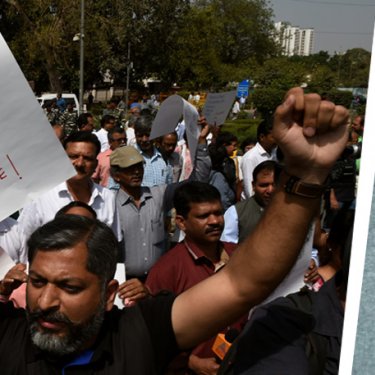Surge in police violence against journalists in India

After at least four cases of police violence against journalists in India in March alone, Reporters Without Borders (RSF) calls on the authorities to take immediate steps to punish those responsible and to end the climate of police mistrust and hostility towards the media.
On 24 March, New Delhi journalists staged a major demonstration about the issue after the latest example of police violence against journalists the day before, when police tried to break up a “pad yatra” (long march) in New Delhi by students and teachers from Jawaharlal Nehru University.
Clearly trying to prevent media coverage of their dispersal of the university protest, the police manhandled and beat journalists, seizing cameras and injuring several reporters including Anushree Fadnavis, a women photojournalist with the Hindustan Times. Given the fact that in the recent past, there had been multiple incidents when scribes had been attacked by the police, many suspect the police were acting on orders from superiors when they resorted to violence.
“We have registered at least four cases of police violence against the media in India in March alone,” said Daniel Bastard, the head of RSF’s Asia-Pacific desk.
“This climate of hostility is intolerable. We urge the authorities to conduct thorough investigations into the violence and to apply the appropriate sanctions. Above all, the ministry of home affairs must issue clear directives to the police in the field, and to those who give them their orders, that the work and the safety of journalists must be respected throughout the country.”
Extreme violence
The latest case was on 25 March, when N. C. Shareef, a reporter for the daily newspaper Suprabhatham, was beaten by police and locked in a cell after going to a police station in Areekode, in the southwestern state of Kerala, in search of information about a local protest movement.
On 10 March, at least seven journalists were injured when police beat them with batons as they tried to cover a student demonstration at the other end of the country, in the northeastern state of Assam.
The victims included Emmy Lawbei of News18 TV, Catherine Sangi of All India Radio and Tridip Mandal of The Quint, who have described how they were badly beaten although they repeatedly tried to tell the police that they were journalists. This can be seen in videos of the events.
Two days before that, a photojournalist who prefers not to be named was attacked by police while covering an operation against traders opposed to the closure of a market in Lajpat Nagar, a southeastern district of Delhi. After he took a photo of a police commander beating a trader, he was beaten by police officers, who took his camera and told him to delete the photo. He and a colleague were then taken to a police station.
Impunity
The surge in cases of police brutality against the media is all the more worrying because it nearly always goes unpunished. The outcome of a similar case of police violence in February 2017 does not bode well. A year later, the report of the investigation that was supposed to shed light on the events is now gathering dust in a cupboard at New Delhi police headquarter without any sanctions having been imposed by the police chief. The officer who conducted the investigation has meanwhile been moved to a more junior position.
At a time when the Indian media are in mourning for the three journalists who were murdered in the space of 24 hours earlier this week, the Indian authorities must now set an example or else India is liable to fall even further in RSF’s World Press Freedom Index, in which it is currently ranked 136th out of 180 countries.



